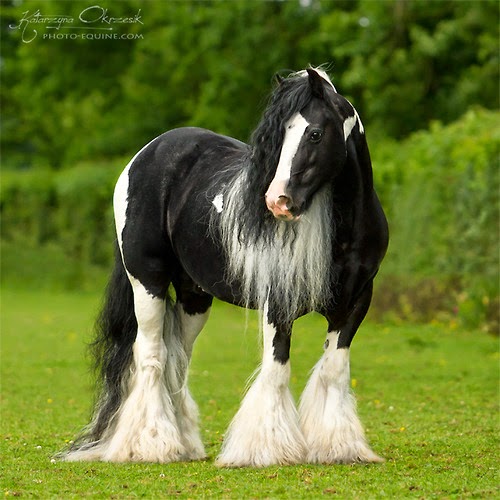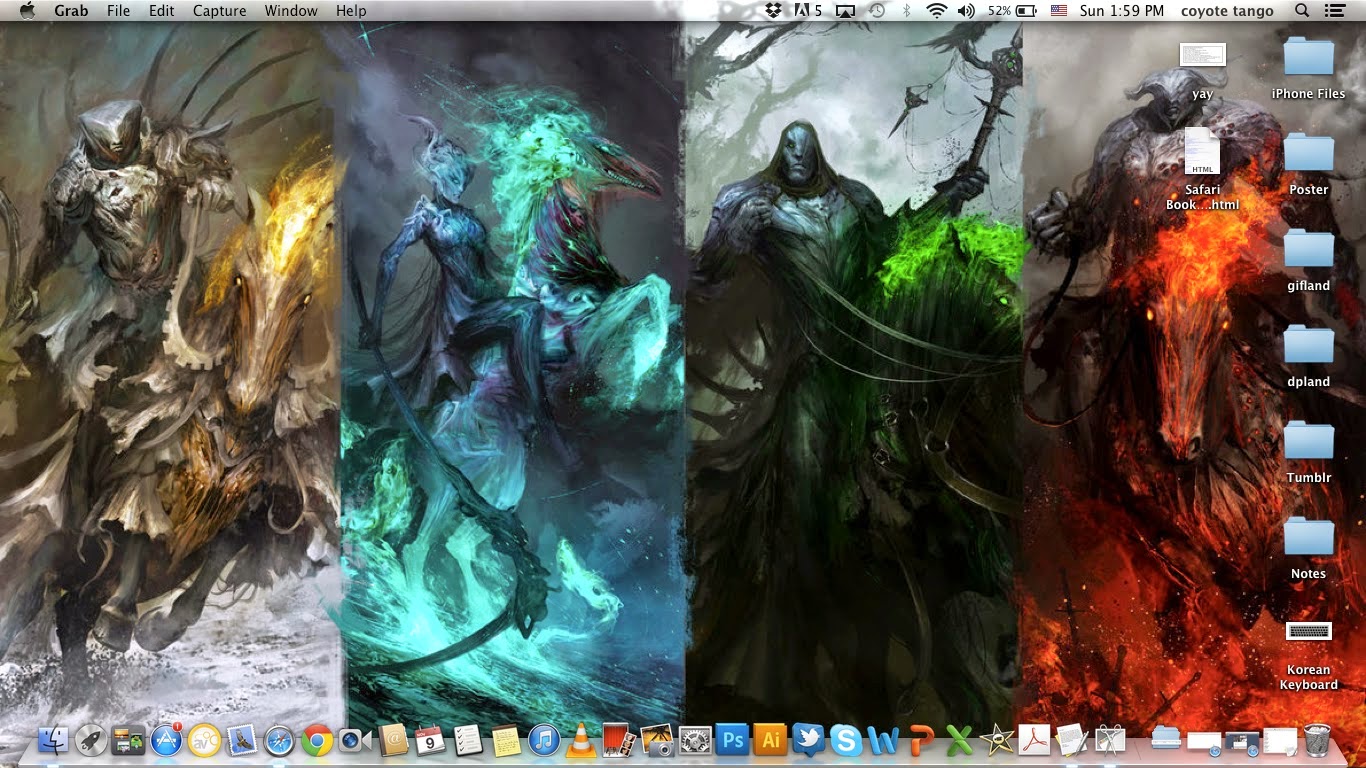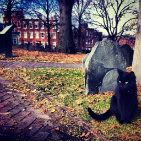it's over so why am I still tired all the time
#1383 but she pressed on, so I lifted my gun, and I fired away
Sunday, 30 November 2014
#1382 I asked her to stop, I begged her to stay
Friday, 28 November 2014
best scene in the show hands down
#1381 she walked through bullets and haze
newfound love for pumps
#1380 we beat him with guns, and batons not just once, but again and again
Tuesday, 25 November 2014
What's that in the mirror, or the corner of your eye?
What's the footstep following, but never passing by?
Perhaps they're all just waiting, perhaps when we're all dead.
Out they'll come a-slithering, from underneath the bed.
#1379 I told them to stop, but then I joined in
In a dream, you walk outside to find your familiar landscape swarming with fantastic beings. Depending on where you live, there might be deer with antlers thick as tree boughs, or something resembling a live armoured tank. There's a herd of what look like camels - except they have trunks. Furry rhinoceroses, big hairy elephants, and even bigger sloths - sloths?? Wild horses of all sizes and stripe. Panthers with seven-inch fangs and alarmingly tall cheetahs. Wolves, bears, and lions so huge, this must be a nightmare.A dream, or a congenital memory? This was precisely the world that Homo sapiens stepped into as we spread beyond Africa, all the way to America. Had we never appeared, would those now-missing mammals still be here? If we go, will they be back?...Mammoths were grazing animals, evolved to steppes, grassland, and tundra, unlike their much older relatives, the mastodons, which browsed in woods and forests. Mastodons had been around for 30 million years, and ranged from Mexico to Alaska to Florida - but suddenly they, too, were go. Three genera of American horses: gone. Multiple varieties of North American camels, tapirs, numerous antlered creatures ranging from dainty pronghorns to the stag moose, which resembled a cross between a moose and an elk but was larger than either, all gone, along with the sabre-toothed tiger and the American cheetah (the reason why the sole remaining pronghorn species of antelope is so fleet). All gone. And all pretty much at once? What, Paul Martin wondered, could possibly have caused that?...Martin mourned, but by then he had been setting blazes of his own in the palaeontology world with his theory of what had wiped out millions of ground sloths, wild pigs, camels, Proboscidea, multiple species of horses - at least 70 entire genera of large mammals throughout the New World, all vanished in a geologic twinkling of about 1000 years:
"It's pretty simple. When people got out of Africa and Asia and reached other parts of the world, all hell broke loose."
...[The International Wildlife Museum]'s centrepiece is the faithfully reproduced 2500-square-foot trophy room of McElroy's Tucson mansion, which bears the taxidermised spoils of a lifelong obsession with killing large mammals. Locally often derided as the "dead animal museum", for Martin on this night, it's perfect.The occasion is the launch of his 2005 book, Twilight of the Mammoths. Just behind his audience rises a phalanx of grizzly and polar bears, frozen forever in mid-attack. Above the podium, its ears extended like grey spinnakers, is the trophy head of an adult African elephant. To either side, every breed of spiral horns found on five continents is represented. Pulling himself from his wheelchair, Martin slowly scans the hundreds of stuffed heads: bongo, nyala, bushbuck, sitatunga, greater and lesser kudu, eland, ibex, Barbary sheep, chamois, impala, gazelle, dik-dik, musk ox, cape buffalo, sable, roan, oryx, waterbuck, and gnu. Hundreds of pairs of glass eyes fail to return his moist blue gaze.
"I can't imagine a more appropriate setting," he says, "to describe what amounts to genocide. In my lifetime, millions of people slaughtered in death camps, from Europe's Holocaust to Darfur, are proof of what our species is capable of. My 50-year career has been absorbed by the extraordinary loss of huge animals whose heads don't appear on these walls. They were all exterminated, simply because it could be done. The person who put this collection together could have walked straight out of the Pleistocene."
He and his book conclude with a plea that his accounting of the Pleistocene mega-massacre be a cautionary lesson that stops us from perpetrating another that would be far more devastating. The matter is more complicated than a killer instinct that never relents until another species is gone. It involves acquisitive instincts that also can't tell when to stop, until something we never intended to harm is fatally deprived of something it needs. We don't actually have to shoot songbirds to remove them from the sky. Take away enough of their home or sustenance, and they fall dead on their own.
#1378 they took off his clothes, they pissed in his hands
Monday, 24 November 2014
Listen! Question: Why do we talk out loud when we know we're alone? Conjecture: because we know we are not. Evolution perfects survival skills. There are perfect hunters. There is perfect defense. Question: Why is there no such thing as perfect hiding? Answer: How would you know? Logically, if evolution were to perfect a creature whose primary skill were to hide from view, how could you know it existed? It could be with us every second and we would never know. How would you detect it? Even sense it? Except in those moments when, for no clear reason, you choose to speak aloud. What would such a creature want? What would it do?
You know sometimes when you talk to yourself? What if you're not? What if it's not you you're talking to? Proposition: What if no one is ever really alone? What if every single living being has a... companion. A silent passenger. A shadow. What if the prickle on the back of your neck is the breath of something close behind you?
#1377 we took him away, a bag over his face, from his family and friends
Sunday, 23 November 2014
if only screen printing was readily accessible... then I would be able to design my own shirts including one with imagine dragon lyrics because that shit is beautiful
#1376 the children, they cried, but I got my man
Saturday, 22 November 2014
one of the worst feelings ever is wanting so bad to draw something but not having your drawing coming out the way you want it, so you end up erasing it all away and desperately promising yourself that you will do it another day
#1375 I kicked in the door, I yelled my commands
Friday, 21 November 2014
Das Firmament blaut ewig, und die ErdeWird lange fest steh'n und aufblüh'n im Lenz.Du aber, Mensch, wie lange lebst denn du?Li Tai-Po/ Hans Bethge/ Gustav Mahler
The firmament is blue forever, and the Earth
WIll long stand firm and bloom in spring.
But, man, how long will you live?
The Chinese Flute: Drinking Song of the Sorrow of the Earth
Das Lied von der Erde
#1374 because it's a flag that I love, and a flag that I trust
Tuesday, 18 November 2014
how
can
anyone
not
come
to
love
and
admire
these
proud
elegant
and
noble
creatures
?
drew three horses today (well two really rough sketches and one not so rough sketch) that really didn't do them any justice. despite chemistry tomorrow. and I still want to draw more. one simply does not ignore the call of the sketchbook.
can
anyone
not
come
to
love
and
admire
these
proud
elegant
and
noble
creatures
?
drew three horses today (well two really rough sketches and one not so rough sketch) that really didn't do them any justice. despite chemistry tomorrow. and I still want to draw more. one simply does not ignore the call of the sketchbook.
#1373 I'll carry this flag, to the grave if I must
Sunday, 16 November 2014
inspirational badass song
#1372 and when I come home, they'll be damn proud of me
Saturday, 15 November 2014
the past month or so has just been this huge burn out period where I stare blankly at my shit, knowing full well that there's still so much to cram, but I just can't bring myself to do it any longer
#1371 a hero of war, yeah that's what I'll be
ten more days and I'll be out of this shitty system
#1370 we all became friends, as we learned how to fight
Friday, 14 November 2014
#1369 we marched and we sang
Tuesday, 11 November 2014
#1368 they cut off my hair, but it looked alright
Sunday, 9 November 2014
#1367 black leather boots, spit-shined so bright
Thursday, 6 November 2014
I don't have that many papers left, which is great, but the bad news is that they are spread over three. bloody. weeks.
#1366 just carry this gun, and you'll even get paid
Wednesday, 5 November 2014
I wouldn't know how to answer this
#1365 he said, "son, have you seen the world?"
"Ideas are bulletproof"
"We are told to remember the idea, not the man, because a man can fail. He can be caught, he can be killed and forgotten, but 400 years later, an idea can still change the world."
"Remember remember, the Fifth of November, the Gunpowder Treason and plot // I know for no reason why the Gunpowder Treason should ever be forgot"
"We are told to remember the idea, not the man, because a man can fail. He can be caught, he can be killed and forgotten, but 400 years later, an idea can still change the world."
"Remember remember, the Fifth of November, the Gunpowder Treason and plot // I know for no reason why the Gunpowder Treason should ever be forgot"
#1364 it's over now the music of the night
Tuesday, 4 November 2014
#1363 it's in your soul that the true distortion lies
Monday, 3 November 2014
psa: stay away from chili
#1362 past the point of no return, the final threshold
Sunday, 2 November 2014
oh English. crossing the rubicon tomorrow, may the journey be hackneyed and not cataclysmic, may it be inconsequential and not sisyphean. yes this is me trying to cram bombastic words into my head (as usual) together with random numbers (they've all but prendre la poudre d'escampette) and not to forget so many different news of goings-on around the world that I make a news reporter look like he's reading a puerile, ingenuous tale of happy endings.
[pretty sure I've used most of these words wrongly - french one included - oh but heck] [not like I'll be getting straight As anyway]
#1361 abandon thought and let the dream descend
Saturday, 1 November 2014
how do you weigh constant chipping in for two years against stagnancy for the first year and a half followed by desperate cramming in the last? how do you weigh? or is this just me telling myself I've done enough? that consistency is better than cramming? that if I've done it before, I can do it again? or is this me being disillusioned, trying to comfort myself when I see the once stationary chess pieces closing in around me, gaining ground, and it is now my turn to remain silent?

























